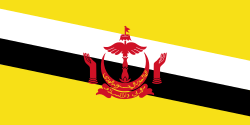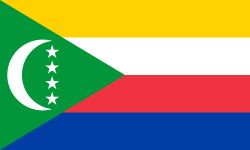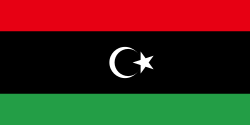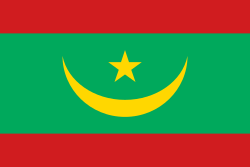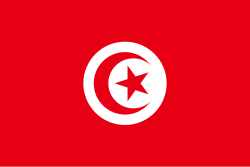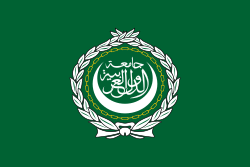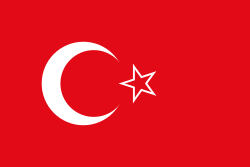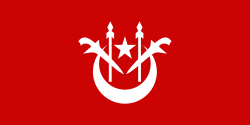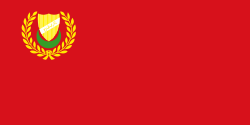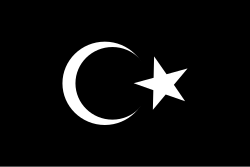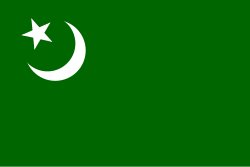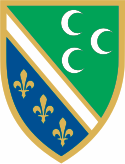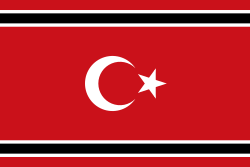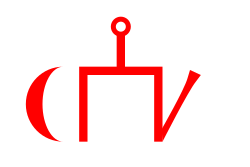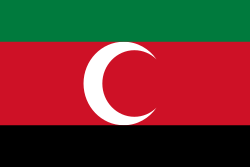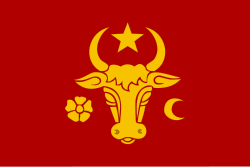Hilal (Mondsichel)
Hilal (arabisch هلال, DMG hilāl ‚Mondsichel‘) ist die arabische Bezeichnung für die schmale Sichel des zunehmenden Mondes nach Neumond. In stilisierter, allgemein als „Halbmond“ bezeichneter Form ist sie heute eines der bedeutendsten muslimischen Embleme und wird auf zahlreichen Flaggen von Staaten, Territorien oder Organisationen dargestellt, wo der Islam maßgebend ist.[1]
Geschichte des Symbols
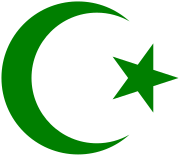
Im vorislamischen Arabien bezeichnete Hilal sowohl den Mondgott des Volkes der Thamud[2] als auch die ganz schmale Mondsichel, wenn sie nach dem Neumond erstmals sichtbar wird.[3] In der persischen und sassanidischen Kunst fand das Symbol Verwendung auf Münzen. In die islamische Kunst wurde die Mondsichel als dekoratives Element übernommen. Beim Bau des Felsendomes in Jerusalem fand die Sichel Verwendung in Mosaiken. Auch islamische Münzen verwendeten das Motiv. Im religiösen Bereich fand das Symbol Verwendung als Abschlussmotiv von Minaretten oder auf Darstellungen der Kaaba.[4]
Als Mondsichel mit einem Stern auf rotem Grund wurde das Symbol zu Beginn des 19. Jahrhunderts als Flagge der osmanischen Armee eingeführt.[4] Während der vergangenen zwei Jahrhunderte entwickelte sich die Mondsichel in muslimischen Ländern zu einem bedeutenden Symbol[5][6] und fand Einzug in die Heraldik zahlreicher islamischer Staaten. Zudem ist er – analog zum Internationalen Roten Kreuz – das Zeichen des Internationalen Roten Halbmonds. Auch Organisationen, deren Lehren relativ stark von denen des orthodoxen Islam abweichen, wie beispielsweise die Nation of Islam („Black Muslims“) in den USA, verwenden das Symbol.[4]
Bedeutung im Islam
Das Islamische Jahr richtet sich ausschließlich nach dem Mondkalender. Zahlreiche religiöse Feste und andere Termine hängen mit dem Erscheinen des neuen Mondes zusammen. So beginnt auch der Fastenmonat Ramadan erst mit dem Erscheinen der Mondsichel. Dieses Ereignis musste in der sunnitischen Welt von mehreren Zeugen gemeldet werden. Aufgrund meteorologischer Bedingungen konnte es zu Verschiebungen kommen. Religiöse Autoritäten konnten nach einer festgelegten Zeit auf Basis astronomischer Berechnungen den Beginn des Ramadans erklären, ohne dass der Mond gesichtet wurde.[4] Ein anderes wichtiges Ereignis, das durch die Sichtung des Neumonds bestimmt wird, ist beispielsweise der Beginn des Pilgermonats Dhū l-Hiddscha.[7]
Fundstellen im Koran und Mondsichtung
Der Hilal wird in zahlreichen Stellen im Koran erwähnt, beispielsweise in Sure 2 Elbakara Vers 189:
„Sie fragen dich nach den Jungmonden. Sag: Sie sind festgesetzte Zeiten für die Menschen und für die Pilgerfahrt. Und nicht darin besteht die Frömmigkeit, daß ihr von der Rückseite in die Häuser kommt. Frömmigkeit besteht vielmehr darin, daß man gottesfürchtig ist. So kommt durch die Türen in die Häuser und fürchtet Allah, auf daß es euch wohl ergehen möge!“
Eine andere in diesem Zusammenhang relevante Passage, in der allerdings der Begriff nicht vorkommt, ist der Vers 183–184 in der gleichen Sure, in der die Bedeutung des Fastens betont wird und zwar für bestimmte (wörtlich: abgezählte) Tage:
„183: O die ihr glaubt, vorgeschrieben ist euch das Fasten, so wie es denjenigen vor euch vorgeschrieben war, auf daß ihr gottesfürchtig werden möget. 184: (Vorgeschrieben ist es euch) an bestimmten Tagen. [...]“
Über die Frage, ob der Jahresverlauf auch durch Berechnung (hisāb) bestimmt werden könne, gibt es einen Dissens innerhalb der islamischen Gemeinschaft. Während dieses Verfahren von einer großen Mehrheit der Sunniten und den Zwölfer-Schiiten abgelehnt wird, haben andere Gruppen wie die Ismailiten dieses Verfahren weitgehend akzeptiert. Als Argument für die Berechnung wird der Begriff „ayaman maʿdūdāt“ (in etwa: „abgezählte Tage“) angeführt, welcher in der oben genannten Sure verwendet wird. Die Gegner dieser Ansicht führen jedoch eine authentische Überlieferung an, in der Muhammad davon sprach, das Fasten nur dann zu beginnen und zu beenden (also jeweils zum Beginn und Ende des Ramadans), wenn der Mond tatsächlich gesichtet wurde. Islamrechtliche Fragen zur Mondsichtung werden nach wie vor durch verschiedene Gruppen unterschiedlich beurteilt. Die Zwölfer-Schiiten jedoch halten streng am Prinzip der Sichtung fest (strenger als die Sunniten) und lehnen die Berechnung der Mondphasen kategorisch ab.[7]
Liste der Flaggen mit Hilal
- Aktuell existente, anerkannte, souveräne Staaten
- Teilgebiete aktuell existenter, anerkannter, souveräner Staaten
- Kokosinseln (Australien)
- Anjouan (Komoren) bis 2012
- Anjouan seit 2012
- Johor (Malaysia)
- Kedah (Malaysia)
- (c) Mysid, CC BY-SA 3.0Kelantan (Malaysia)
- Selangor (Malaysia)
- (c) Mysid, CC BY-SA 3.0Terengganu (Malaysia)
- Karakalpakistan (Usbekistan)
- Umm al-Qaiwain (Vereinigte Arabische Emirate)
- Aktuell existente, nicht allgemein anerkannte Staaten
- Flaggen historischer Staaten und Territorien
- Eyâlet Ägypten (1517–1882)
- Khedivat Ägypten (1882–1914)
- Sultanat Ägypten (1914–1922; nach der persönlichen Standarte Muhammad Ali Paschas)
- Ägyptische Revolutionsfahne (1919)
- Königreich Ägypten (1922–1953)
- Ägyptische Revolutionsfahne (1952)
- Westherzegowinische Kriegsflagge (1760)
- Bosnien und Herzegowina (1831–1832, 1878)
- Vilâyet Tripolitanien (1864–1911)
- Kyrenaika (1949–1951; nach dem Banner des Senussi-Ordens)
- Königreich Libyen (1951–1969)
- Standarte des libyschen Königs Idris
- Flagge des Osmanischen Admirals (ca. 1326)
- Seekriegsflagge des Osmanischen Reichs (1453–1517) und Flagge des Osmanischen Reiches (1453–1517)
- Kriegsflagge des Osmanischen Reiches (ca. 1500–1793)
- Kriegsflagge des Osmanischen Reiches (1517–1793)
- Seekriegsflagge de Osmanischen Reichs (1513–1793)
- Osmanisches Reich (1517–1844)
- Osmanisches Reich (1844–1923)
- Republik Hatay (1938–1939)
- Völkerbundmandat für Syrien und Libanon (1920–1922)
- Französisch-Tunesien (1881–1956)
- Protektorat von Südarabien (1959)
- Südarabische Föderation (1962 und 1967)
- Königreich Kurdistan (Oktober 1922 bis Juli 1924)
- Südwest-Kaukasische Republik (1918–1920)
- Fur-Sultanat (18.–19. Jahrhundert)
- Emirat von Dschebel Schammar (1836–1921)
- Fürstentum Moldau (1346–1859)
- Fürstentum Walachei (1310–1861)
- Khanat der Krim (1449–1783)
- Königreich Tlemcen (1235–1338, 1488–1556)
- Königreich Tlemcen (1338–1488)
- Hafsiden (ca. 15. Jahrhundert)
- Sultanat Fadli (1670–1967)
- Emirat Beihan (ca. 17. Jahrhundert-1967)
- Wahidi Balhaf (ca. 1640–1967)
- Emirat Dhala (ca. 15. Jahrhundert-1967)
- Autonome Republik Aserbaidschan (1945–1946)
- 2. Republik Ostturkestan (1944–1949)
- Bahawalpur (1885–1945)
- Bahawalpur (1945–1955)
- Barwani
- Republik Suvadiva (1959–1969)
- Mahra (1549–1967)
- Emirat Diriyah (erster Saudischer Staat) (1744–1818)
- Rif-Republik (1921–1926)
- Khanat Chiwa (1511–1920)
- Basmatschi (1921–1924)
- Goldene Horde (ca. 1240–1502)
- Autonome Alaş (1917–1920)
- Autonome Kokand (1917–1918)
- Volksrepublik Buchara (1920–1924)
- Emirat Buchara (1599–1920)
- Sultanat von Aceh (1511–1903)
- Sonstige Flaggen und Logos
- Masyumi-Partei (Indonesien)
- Nation of Islam (USA)
- Alternative Flagge der irakischen Turkmenen und der Turkmenenfront
- Flaggenvorschlag für den post-baathistischen Irak aus dem Jahr 2004
- Westsomalische Befreiungsfront Äthiopiens (Ogaden)
- Deutsch-Türken (inoffiziell)
- Unabhängigkeits-bewegung von Aceh (Indonesien)
- Separatisten in Riau (Indonesien)
- Tatarisches Zentrum
- Minderheitenflagge der turkstämmigen Belarus-Tataren
- Sandžak-Bosnier
- Sanxhak-Albaner
Siehe auch
Weblinks
Einzelnachweise
- ↑ Die Mondsichel ist bemerkenswerterweise zumeist seitenverkehrt dargestellt. Auf der Nordhalbkugel öffnet sich die zunehmende Sichel des Mondes nämlich nach links.
- ↑ Rafat Amari: Islam: In the Light of History, Prospect Heights (Illinois) 2004, S. 275.
- ↑ Gertrude Caton Thompson: Tombs and Moon Temple of Hureidah, 1944, S. 76
- ↑ a b c d Adel Theodor Khoury, Ludwig Hagemann, Peter Heine: Lexikon des Islam – Geschichte – Ideen – Gestalten. Directmedia, Berlin 2001, Digitale Bibliothek Band 47. Stichwort Hilal
- ↑ Das Symbol der Mondsichel mit Stern befindet sich auch auf der 2011 wieder eingeführten Nationalflagge Libyens und wird in einer englischsprachigen Broschüre (The Libyan Flag & The National Anthem, herausgegeben vom Ministerium für Kultur und islamische Führung des Königreiches Libyen, Datum der Veröffentlichung nicht genau bekannt, zitiert nach Jos Poels aufFOTW ( vom 4. November 2015 im Internet Archive), 1997) wie folgt erklärt:
„The crescent is symbolic of the beginning of the lunar month according to the moslem calendar. It brings back to our minds the story of Hijra (migration) of our prophet Mohammed from his home in order to spread Islam and teach the principles of right and virtue. The Star represents our smiling hope, the beauty of aim and object and the light of our belief in God, in our country, its dignity and honour which illuminate our way and puts an end to darkness.“
[„Die Sichel steht für den Beginn eines Mondmonats im Sinne des muslimischen Kalenders. Sie erinnert uns an die Geschichte der Hidschra (Auszug) unseres Propheten Mohammed aus seiner Heimat, um den Islam und die Prinzipien von Recht und Tugend zu verbreiten. Der Stern repräsentiert die strahlende Hoffnung, die Schönheit von Streben und Sinn und das Licht unseres Glaubens an Gott, an unser Land, seine Erhabenheit und Ehre, die unseren Weg erleuchten und der Dunkelheit ein Ende setzen.“] - ↑ Hilal – Der Halbmond als Erkennungszeichen FOCUS online Islamlexikon
- ↑ a b J.Schacht in: Encyclopaedia of Islam, Second Edition, Band 3, Brill:Leiden 1986, S. 379f
Auf dieser Seite verwendete Medien
Flagge der Malediven.
Flag of Mauritania, adopted in 2017. The National Assembly added red stripes to the top and bottom edges to represent “the blood shed by the martyrs of independence”.
flag of the Kingdom of Egypt (1922–1953) and the Republic of Egypt (1953–1958).
A green flag with a white inscription above a crescent moon with horns upwards, all within a circle of chain and all around a white wreath with a ribbon at the base. Proportion 2:3 reported in Pavillons nationaux et marques distinctives. FOTW
- in the center an Arabic script for "League of Arab States" (Arabic: جامعة الدول العربية)
- Proportion 2:3 as reported.
- Green similar to 60 Years anniversary flag shown on the official site.
Flag of the short lived Azerbaijan People's Government
Autor/Urheber: A. Özgür Erdemli, Lizenz: CC BY-SA 3.0
Flag of the Republic of Hatay (1938-1939; today Turkey's province)
Autor/Urheber: Guilherme Paula, Lizenz: CC BY-SA 3.0
Flag of an Admiral of the Ottoman Navy, instituted some time after the conquest of Constantinople in 1453.
The revolution flag of Egypt from 1919. It bears a crescent and cross to demonstrate that both Muslims and Christians supported the Egyptian nationalist movement against British occupation.
Autor/Urheber: TRAJAN 117, Lizenz: CC BY-SA 3.0
Flag of Egypt, used in the 19th century.
Traditional banner of the Senussi and flag of Cyrenaica from 1949-1951.
Autor/Urheber: DrFO.Jr.Tn, Lizenz: CC BY-SA 3.0
WARNING: This is a "possible reconstruction" of a Hafsid flag of the 15th century (unreferenced). There are some depictions of Hafsid flags in 15th century manuscripts. They appear to show a crescent, or a double crescent, on a yellow flag.
The upward-pointing crescent (without the star) can be traced to the Catalan Atlas collected by Charles V le Sage c. 1370, where it is attributed to the port city of Gabes.flag of the Kingdom of Egypt (1922–1953) and the Republic of Egypt (1953–1958).
NOTICE: This flag was not used to represent the French protectorate of Tunisia.
The flag was used by some military units based in Tunisia while the French Protectorate of Tunisia.Flag of the Emirate of Dhala
(c) Guilherme Paula, CC BY-SA 3.0
Flagge von 1760, von Landbesitzern in der Westherzegowina hauptsächlich im Krieg verwendet.
"Kokbayraq" flag, used by the Uyghurs as a symbol of the East Turkestan independence movement. The Chinese government prohibits using the flag within China.
Autor/Urheber: Froztbyte, Lizenz: CC BY-SA 3.0
Flag of Bosnia (1831-1832) - used during the Bosnian Revolt in the 1830s. The design, 1:2 dimensions, colours and construction details were based primarily on the description from FOTW: Bosnia and Herzegovina in the Ottoman Empire - Flag of the 1830's Revolt.
Flag of Umm al-Qaiwain
Flag of Khanat of Crimea in Empire: Total War. Modern reconstruction
Autor/Urheber: Samhanin, Lizenz: CC0
Flag of the Khanate of Khiva, "The museum of Khiva displays (vertically) the flag used by the khanate of Khiva during the civil war (1917-1922). The khanate, which had been annexed by Russia in 1873, proclaimed independence on 13 February 1917. In 1918, the khan was overthrown by a Turkmen chief. Then began a period of anarchy. The protectorate of Khiva was suppressed on 9 April 1919 and Khiva was included in the new Republic of Khorezm, created by the Soviets on 26 April 1920."
Inoffizielle deutsch-türkische Flagge
Flag of the Uzbek Emirate of Bukhara.
Flago de la Kokosinsuloj, uzo ne oficiala
Turkmenenflagge
Autor/Urheber: Пакко, Lizenz: CC BY-SA 3.0
Royal standard of King Idris of Libya
Flag of the Emirate of Beihan
Flag of Wahidi Balhaf in Hadhramaut
Fictitious flag of the Ottoman Navy.
Bandera del Turquestan Unificat
Flag of the Second East Turkestan Republic (1944-1949)
Depiction of an Ottoman "Zulfikar flag" typically in use during the 16th and 17th centuries.
The design is a rough approximation of the Zulfikar flag used by Selim I in the 1510s, File:Türkei Seidenfahne makffm.jpg
- " During the 16th-17th centuries the Zulfikar flags were widespread in Ottoman army and numerous red Zulfikar flags left in the battles in Europe are shown in museums and one can even see a red, triangular Zulfikar flag in the Doge Palace in Venice." Bariş Kılıçbay, 20 August 1999 (crwflags.com)
Original raster (.png) version uploaded by Ingoman.
Vector (.svg) version created by Kevyn using VectorMagic.com.Proposal for the flag of the Alash Autonomy.
Flag of the Malaysian state Johor. FOTW says:
- Johore has a blue flag, with a big red canton with white crescent and five-pointed star, pointing somewhere, but not exactly in lower fly end. (…) The flag consists of a white crescent and a star of five points on a red field at the canton and navy blue at the fly. The white denotes a sovereign ruler, red a warrior and blue the universe. This flag is very much associated with the Sultan.
A proposal for the a future Iraqi flag by the Coalition Provisional Authority from 2004, rejected after widespread criticism.
Autor/Urheber: Ранко Николић, Lizenz: CC BY-SA 3.0
National coat of arms of Bosniac National Council
the "Arab Liberation" flag associated with the Egyptian officers' coup of 1952, used as the flag of Egypt from 1952 to 1958. Note: For some purposes the flag of a white crescent and three stars on green was still used until 1958.
Flag of the Fadhli Sultanate
One of the several maritime flags of Ottoman Tripolitania used during Karamanli era (1711-1835). Based on Johnson's new chart of national emblems of 1868. A similar flag, with the crescents moved towards the hoist, is recorded in the 1750s as the naval flag of the "Turkish Emperors" (Türckische Kayser) in Flaggen aller seefahrenden Nationen.[1]
Autor/Urheber: Guilherme Paula, Lizenz: CC BY-SA 3.0
Flag of the Emirate of Ha'il
Flag of Janjira
Autor/Urheber: Samhanin, Lizenz: CC0
Flag of State of Bahawalpur (1885-1945)
Flag of the State of Bahawalpur from 1945 until the abolition of the state in 1955
Possible flag of the French Mandate of Syria between July 24 - September 1, 1920.
Autor/Urheber: historicair 16:39, 1 May 2007 (UTC), Lizenz: CC BY-SA 3.0
Drapeau de la République arabe islamique (Union tuniso-libyenne) d'après la description figurant dans le protocole de l'union rapporté dans le livre Les trois décennies Bourguiba de Tahar Belkhodja
Autor/Urheber: Darwinek, Lizenz: CC BY-SA 3.0
Flag of the Independent Government of Western Thrace (AKA Turkish Republic of Western Thrace, Republic of Gumuljina [3]).
Flag of the United Suvadive Republic
Flagge des Mahra Sultanate of Qishn and Socotra bis 1967
Flag used by Tatar nationalists
Autor/Urheber: Orange Tuesday, Lizenz: CC BY-SA 3.0
Flag of Anjouan since 2012
Flag of the Kayihan Khanate
Flag of the Ottoman Empire (c. 1750s).[1]
A variety of Ottoman naval flags with crescents are recorded in Western sources during the 18th century.
Flaggen aller seefahrenden Nationen shows several Turkish naval flags with three crescents (heraldic decrescents, horns pointing away from the hoist as in the later Ottoman flag)Flag of the Zayyanid
The Ottoman flag and Turkey Republic Flag of 1844–1935. Late Ottoman flag which was made based on the historical documents listed in the Source section. Note that a five-pointed star was rarely used in the crescent-and-star symbol before the 19th century.
Autor/Urheber: Guilherme Paula, Lizenz: CC BY-SA 3.0
Flag of the First Saudi Nejd Emirate
Autor/Urheber: Vorziblix, Lizenz: CC0
The flag of the Golden Horde, as shown in Angelino Dulcert's 1339 map. A similar flag appears in the later Catalan Atlas (1375), providing corroboration.
See also Early Mongol Flags at crwflags.com:
- One of the charges is a crescent and the other looks like a simplified form of the tamga from the flag of Idel Ural. On different copies of the flag, the crescent has different size; it is often smaller than shown here, sometimes even reduced into a simple oblique stroke and conjoined with the other charge into a si[n]gle symmetrical object; the other charge also sometimes lacks the oblique part [2, 3]. It was obviously difficult to draw the charges always the same way. The cities with this flag which are easy to identify are [2, 7, 8]: Sarai, the capital (spelled Sarra) - there is also a depiction of the ruler, "Jani Beg Lord of Sarai" ("Jambech senyor de Sarra"); Tana, present-day Azov, Russia; and Urgench, Uzbekistan (spelled Organci, with a cedilla under the c; nowadays ruined). This flag is a variant of the flag of "Emperor of Sarai" ("Emperador de Sara") from "Libro del conoscimiento de los reinos" [7] and might be the one that had really existed, considering the similarity of its charges with those from the flag of Idel Ural.
- [2] Enciclopedia universal ilustrada, vol. XXI, Espan~a Madrid: Espasa-Calpe S.A., 1968
- [3] Istorija otkric'a i istraz<ivanja, vol. I: Poc<etak istraz<ivanja; Mladinska knjiga, Ljubljana, 1979; Original title: A History of Discovery and Exploration, vol. I: The Search Begins;(C) 1973 Aldus Books Limited, London
- [7] Libro del Conoscimiento. Viajes medievales, vol. I Madrid: Fundacio'n Jose' Antonio de Castro, 2005 ISBN 84-96452-11-5 (complete edition) ISBN 84-96452-12-3 (vol. I) [e9s50]
- [8] A[p]pendices. (Ibid.)
- Tomislav Todorovic, 21 April 2007
Flag of the Darfur Liberation Front, Sudan.
Autor/Urheber: Froztbyte, Lizenz: CC BY-SA 3.0
Flag of the South West Caucasian Republic (1918-1919) - colours and 2:3 dimensions partly based on template at FOTW
(c) Mysid aus der englischsprachigen Wikipedia, CC BY-SA 3.0
Flag of the Malaysian state Selangor.
Flag of the Bukharan People's Soviet Republic 1921–1923.
Autor/Urheber: Kabyle20, Lizenz: CC BY-SA 3.0
Flag in different painting about Algiers's ship from 18th to early 19th century reported by hukam.net[1].
Autor/Urheber: WikiCobalt-Chloride-, Lizenz: CC BY-SA 4.0
The flag of the Khanate of Kalat (-1955).
Image of the flag of the Federation of South Arab Emirates (or Federation of Arab Emirates of the South), created in 1959, that became the Federation of South Arabia (which used the same flag) in 1962. These structures replaced the British Colony of Aden and the Aden Protectorate.
Contemporary reconstruction. Flag of Moldavia in the 15th-16th centuries. Made after: Seal of en:Alexandru cel Bun (1400-1432) from the National Museum of History of Romania. [1], Image:AlexandruCelBunSeal.png, Image:StefanCelMareSeal.png. The first information regarding the color of the Moldavian flag (including elements) comes from a book of documents published in Krakow in 1533: The grand flag had a red field on which was nicely painted with gold the coat of arms of Moldavia (banderim magnum sericeum, coloris rubri, in quo arma terrae Moldaviae pulhre auro depicta erant).
Autor/Urheber: Inah xrem, Lizenz: CC BY-SA 4.0
Sanxhak Flag; Flag of Sanxhak representing the Albanian ethnicity living in the region; Sandžak Flag; Flag of Sandžak representing the Albanian ethnicity living in the region
Autor/Urheber: Omar-Toons, Lizenz: CC0
The flag of the Kingdom of Tlemcen from 1338 to 1488 according to http://www.hubert-herald.nl/Algeria.htm
Flag of Ogaden Liberation Front
Flag of the Turkestan (Kokand) Autonomy 1917-1918
A symbol of Islam, the star and crescent, in a green. Created by Kbolino in Inkscape, who releases the image into the public domain for all intents and purposes.
This image is NOT the Flag of the Maghreb Union; it was sourced to Flags of the World, but has not been found anywhere else, including on the Maghreb Union's official website, or at their physical headquarters
Flag of the Nation of Islam. The design of the flag is influenced by the Turkish flag. Letters on the flag means Justice, Freedom, Equality, Islam.


























































































